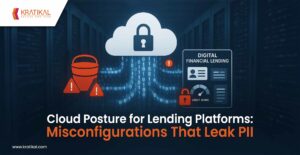Increase by 61%! Yes, nearly 2/3rd of organizations experienced a cloud security incident in 2025, a significant increase compared to 2024. 85% of organizations now identify security as the biggest challenge in cloud computing. These facts testify to the need for cloud configuration. Cloud adoption is at an all-time high in 2025, bringing significant security challenges that often lead to costly data breaches.
Below, we detail the top cloud security challenges of 2025 along with strategies for mitigation.
Table of Contents
Top Cloud Security Challenges in 2025
Misconfigurations and Human Error
Gartner predicts that by 2025, 99% of cloud security failures will be the customer’s fault, and the driving factor will be due to misconfigurations. Misconfigured storage buckets, databases, or access policies can inadvertently expose sensitive data. Among them, cloud misconfigurations account for roughly 15% of breach incidents.
In one 2025 case, a global automotive firm accidentally exposed 10TB of customer data via a misconfigured AWS S3 bucket and hard-coded credentials.
A global network services provider inadvertently exposed an internal cloud database to the internet due to a configuration error. In February 2024, a researcher discovered that this misconfigured database contained 384 million records (57 GB), including server logs and some customer contact info.
Mitigation Strategy
Such incidents underscore the need for Cloud Security Posture Management (CSPM) platforms, strict configuration reviews, and automation to catch errors before they turn into breaches.
Identity and Access Management (IAM) Weaknesses
83% of cloud breaches have an access-related component. It stems from weak, stolen, or over-privileged credentials.
In early 2025, the Codefinger ransomware group exploited compromised AWS keys to encrypt numerous companies’ cloud data, effectively holding their S3 buckets hostage.
In mid-2024, an American cloud-based data storage and analytics company suffered a cloud data breach that impacted 160+ organizations. Attackers from the group UNC5537 obtained valid user credentials stolen via infostealer malware, causing losses of over $2 million. Investigations revealed “every incident was traced back to compromised customer credentials,” and at least one victim’s account “did not have multi-factor authentication turned on.”
Mitigation Strategy
These attacks highlight the importance of least-privilege access controls and multi-factor authentication everywhere. Cloud administrators should minimize persistent credentials, rotate keys frequently, and monitor for unusual login behavior. Adopting Zero Trust principles further mitigates the risk of credential abuse.

Shadow IT and Unmanaged Cloud Usage
Surveys find companies use over 1,000 cloud applications on average, with IT aware of only under 10%. Gartner predicts 75% of employees will use technology outside IT’s oversight by 2027. This reflects on the fact that sensitive data might be stored in unsanctioned services with unknown security, creating compliance and data leakage risks. Let’s say your employee saves customer data to a personal cloud drive or tries a new SaaS tool without security vetting! In fact, one-third of data breaches in 2024 involved shadow IT usage, according to IBM’s Cost of a Data Breach report. In a Forbes survey, 21% of companies admitted suffering a cybersecurity event due to an unsanctioned IT resource.
Mitigation Strategy
To tackle shadow IT, you should discover and inventory all cloud services in use. This is done through cloud access security brokers or network monitoring. Establish clear policies for SaaS adoption, and educate staff about AI-powered cloud security tools. Proactive real-time cloud monitoring and managing these unofficial cloud usages is critical to avoid unpleasant surprises.
Compliance and Regulatory Challenges
42% of enterprises cite cloud data security/privacy as a top challenge, underscoring concerns, and these gaps in cloud compliance can lead to regulatory penalties and legal fallout. Regulators increasingly demand strict controls on cloud-hosted data, and organizations are responding by using platforms with vulnerability compliance mapping solutions to audit cloud configurations in real-time and flag issues.
A high-profile example is the EU’s action against Meta (Facebook) in 2023. Meta was fined a record €1.2 billion in May 2023 for failing to comply with GDPR data transfer rules. This massive fine, the largest in GDPR history, highlighted regulatory expectations around cloud data storage and encryption.
In another instance, the U.S. SEC and FTC have penalized a firm with $3 million for cloud security lapses. The reason behind it was for misleading disclosures about a cloud breach.
Mitigation Strategy
Even though the cloud’s distributed nature can make regulatory compliance trickier, multi-cloud deployments and cross-border data flows complicate adherence to data protection laws like GDPR, HIPAA, etc. However, some of the best practices for this cloud security challenge include encrypting sensitive data, keeping thorough audit logs, and clearly assigning security responsibilities between provider and customer. It helps meet obligations. In short, compliance is now a core part of cloud security strategy and must be treated as an ongoing priority.
Insider Threats
According to IBM data, malicious insider attacks in 2025 had the highest average breach cost, nearly $5 million. Trusted employees or contractors with legitimate cloud access can exfiltrate data or disrupt services, and their activities may blend in with normal operations.
In May 2025, a large cryptocurrency exchange, where insiders at an overseas support contractor exfiltrated user data. Discovered via a $20 million extortion attempt, the scheme had been leaking its customer information that included names, contact info, partial SSNs, ID documents over several months. Approximately 69,000 customers were affected,
In 2023, two former employees of a famous American electric vehicle (EV) and clean energy company stole and leaked about 100 GB of confidential data to a foreign media outlet, causing a major breach of both employee and customer information. The leaked trove included PII of over 75,000 people (names, addresses, SSNs of current/former staff) as well as customer bank details, internal schematics, and sensitive product information. The company took legal action against the insiders, but not before the company’s reputation suffered a blow.
Mitigation Strategy
Combating insider threats requires a mix of technology and process. You can implement stricter internal access controls, monitoring user behavior and access logs for anomalies, and deploying “zero trust” internally so that even insiders face verification and monitoring.
Book Your Free Cybersecurity Consultation Today!
Insecure APIs and Interfaces
Cloud services heavily rely on APIs and web interfaces and if these are insecure, attackers can directly manipulate cloud resources or steal data. Improperly secured APIs have been at the root of several recent breaches.
In January 2024, a hacker exploited an unauthenticated API endpoint of a cloud collaboration tool to scrape data of its users. It had a public-facing API that allowed linking the app’s profile usernames to email addresses without proper access control. By manipulating this API, the attacker enumerated and obtained the email addresses of over 15 million users.
Another prominent case was the T-Mobile breach, where attackers abused an insecure API to pull personal data on 37 million customers by running automated queries that the API did not properly limit or authenticate.
Mitigation Startegy
These API-centric breaches show that cloud interfaces must be designed with strict authentication, rate limiting, and input validation. Organizations should enforce strong authentication on every API, use API gateways with rate limiting and threat filtering, and rigorously test APIs for vulnerabilities. Development teams must build security into APIs from the start, and security teams should monitor API traffic for anomalies using tools that detect abnormal request patterns like AutoSecT. Every cloud API needs to be treated as a potential front door and guarded accordingly.
Supply Chain and Third-Party Risks
Approximately 19% of breaches are now traced back to third-party or supply-chain compromises. Your organziation must have entrusted critical operations to third-party cloud services or included open-source components in your cloud apps. This means your security is only as strong as that of your partners. Attackers also target vulnerabilities in widely used cloud software or services (zero-days) to breach many organizations at once.
A dramatic example is the supply-chain breach of a popular file transfer software in May – June 2023, whose impact extended well into 2024. It had a zero-day vulnerability that the Cl0p ransomware gang exploited to steal data from hundreds of organizations worldwide. Notably, British Airways, the BBC, and Boots were all affected because their payroll provider used the software.
Mitigation Startegy
For this cloud security challenge, organizations are ramping up vendor security assessments and requiring stronger security commitments from providers. Technical measures are important too. They may be verifying software integrity and restricting third-party access scopes so that a compromise in one service doesn’t cascade into a broader breach. Maintaining an inventory of all third-party libraries and SaaS vendors is also vital, so you can quickly patch or respond when a new vulnerability surfaces.
Get in!
Join our weekly newsletter and stay updated
Summary of Key Cloud Security Challenges
| Challenge | Impact (Risk) | Mitigation Strategies |
| Misconfigurations | Accidental data exposure (e.g. public cloud storage leak). | Automated config checks (CSPM); secure defaults; DevSecOps training. |
| IAM Weaknesses | Account takeover or data theft via stolen/weak credentials. | Least privilege access; MFA on all accounts; key rotation; monitor logins. |
| Zero-Day Exploits | Breaches/outages from unpatched cloud software vulnerabilities. | Rapid patching and updates; virtual patches (WAF/IPS); routine vulnerability scans. |
| Shadow IT | Sensitive data in unapproved apps outside IT’s visibility. | Discover unsanctioned apps (CASB); enforce usage policies; user education. |
| Data Breaches | Major data leak causing financial loss and reputational damage. | Encrypt data at rest/in transit; monitor access anomalies; backups & incident response plan. |
| Compliance Gaps | Regulatory fines or business restrictions due to violations. | Continuous compliance audits; align configs with standards; maintain logs & encryption. |
| Insider Threats | Insider steals data or sabotages systems (hard to detect early). | Limit privileged access; monitor user behavior; strong offboarding and insider training. |
| Insecure APIs | Attackers exploit vulnerable API endpoints to steal or alter data. | API gateways with authorization & throttling; validate inputs; test and monitor APIs. |
| Supply Chain Risks | Breach of a third-party service or component cascades to clients. | Vet vendors’ security (assessments); restrict third-party access; track and patch dependencies. |
FAQs
- What are the main cloud security challenges in 2025?
The biggest risks are misconfigurations, weak IAM controls, insider threats, and insecure APIs. Each can expose sensitive data or give attackers unauthorized access.
- Why does cloud configuration matter?
A single cloud configuration error can expose entire databases publicly. Tools like CSPM help detect and fix these issues before they cause breaches.
- How can businesses strengthen cloud security?
Adopt Zero Trust, enforce MFA, automate audits, and use real-time monitoring to spot misconfigurations or abnormal activity early.







Leave a comment
Your email address will not be published. Required fields are marked *